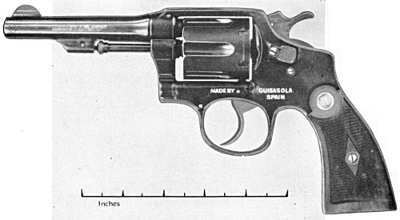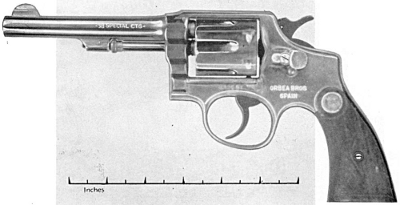The following information on the Spanish imitations of Smith & Wesson revolvers comes from Smith & Wesson Hand Guns by Roy C. McHenry and Walter F. Roper. Smith & Wesson Hand Guns is also available to purchase in print.
Smith & Wesson, Colt and other top-notch American manufacturers always had to contend with cheap imitations of their products as quickly as patents expired; but cheap domestic revolvers never were as troublesome as the Spanish imitations which flooded the country in the early 1920’s.
Arms manufacture in Spain dates back to prehistoric times. Long before Julius Caesar started his campaigns, the Celto-Iberian smiths were forging the long, edged iron swords which the Gauls used with such telling effect on their enemies. Later, the Spanish armorers learned the metal working secrets of the Moors, and the Toledo blade held a high rating among edged weapons from the time of the Crusades until the sword was superseded by firearms.
Spanish gunsmiths made calivers and dags soon after they were invented, and during the Seventeenth Century were turning out long, slender flintlock guns much favored by the Scots. The proportions and outlines of these old smooth-bores were reflected in the Pennsylvania rifles of the next century.
The importation of Spanish firearms into this country practically ceased after the American Revolution, and few Americans of modern times were aware that the manufacture of firearms—especially cheap ones—was one of Spain’s principal industries.
Americans visiting the Latin-American countries sometimes returned with stories of automatic pistols and revolvers looking almost exactly like the American weapons, but curiosity about their origin or manufacture was negligible. Truth was, the patent laws of Spain differed radically from those of other countries. A foreign inventor or owner of a patent could obtain Spanish recognition of his claims upon payment of a moderate fee. But unless, within three years, he established a plant in Spain for the manufacture of his patented articles, his invention became common property and anyone was free to manufacture under his patents without fear of infringement suits.
Return of our expeditionary forces in late 1918 and 1919 probably helped the American public become more “gun conscious” than it had been since frontier days. People who had never before owned firearms began to want revolvers and pistols, and as is always the case, demand creates supply.
New lines of revolvers began to appear in show windows of the cheaper stores. To the casual observer they seemed to be Smith & Wessons and Colts, and as the price was low, many were sold. Only when they were examined more closely was it apparent that the names “Colt” and “Smith & Wesson” stamped upon them applied to the cartridges they were supposed to shoot, and not to the firms manufacturing them. They carried the added inscription “Made in Spain,” and the name of some unfamiliar maker like Guisasola and Orbea Bros.
Externally, these guns were not unprepossessing. They were nicely polished and the bluing was quite good. Mostly they simulated the Smith & Wesson Military & Police Model and the corresponding .38 Colt models.
Not until the cylinders were revolved and the triggers pulled was the worthlessness of the weapons exposed. Cylinders failed to index accurately and the action, instead of being smooth and precise, worked like a coffee grinder.

The rifling in the barrels looked all right to the naked eye, but when examined under a magnifying glass and a strong light it exhibited humps and ridges which didn’t belong there. One disgusted purchaser turned his gun over to a metallurgist, who reported that the barrel and cylinder were of cast iron, such as was ordinarily used for stove lids, and that the parts making up the action were not much better.
Smith & Wesson did not realize immediately how much the Spanish imitations were hurting their business. When they did, some time was required to learn who was at the bottom of the import business. Three firms were found to be responsible: Aaron Newmark, doing business as the Paramount Trading Company; E. E. Glick, operating under the revealing title of Import Trading Company; and an individual named J. L. Galef.
Since patents covering the imitated Smith & Wesson revolvers had all expired, infringement suits were out of the question, and it was decided to bring injunction suits against the importers for unfair competition in trade. It is customary, in suits of this nature, to apply first for a preliminary injunction, restraining the defendants from performing the acts complained of, pending determination by the court of the wisdom and justice of granting a permanent injunction.

Action was brought in the United States District Court for the Southern District of New York and came up before Hon. Learned Hand, U.S. District Judge. On March 27, 1922, he handed down his decision on the application for a preliminary injunction, of which the following is a part:
“…There appears to me not the slightest question that all the infringing revolvers were deliberately made for the purpose of imitating a model of the plaintiff’s. In the case of Galef and Newmark they correspond in dimensions even by gauge, a coincidence wholly impossible in the absence of conscious imitation. In the case of Gluck, the visual similarity is as complete. Such things do not happen because manufacturers are merely following old patents.
“Little identical features in the two lay the matter beyond doubt, if doubt could remain. For example, in all the revolvers the manufacturers have added a circle to indicate a center bushing for the firing pin, which does not exist, a conclusive evidence of intention at least to cheat the buyer. Again, the squaring of the barrel at the frame end is totally unnecessary or useless, despite the defendants’ insistence to the contrary. The barrel, if continued cylindrical as in the Colt, would not interfere with the ejector pin; and if it did, there was no need to do more than grind off a segment. To give it the shape it actually has was certainly not necessary. In section it is not circular at all, not even circular with a segment missing. The stop on the left to hold the chamber when it is swung out of position has been copied in shape literally, and no explanation is suggested for it, as none can be. The lettering along the top of the barrel, except in the case of Exhibit Number One in Newmark’s case, is either a plain fraud, e.g., in Galef’s revolvers, or merely fatuous nonsense. That upon the side of the barrel is little better, and serves no real purpose. To copy the profile of the front end of the frame was equally unnecessary. Why combine the Smith & Wesson ejector pin with this profile? Why not combine the Colt profile with the Smith & Wesson pin? Any saving in metal is trifling…
“The combination of all these features being, as I have said, an unescapable evidence of purpose to imitate, the only conclusion I can come to is that that purpose was in turn actuated by the desire to sell the Spanish revolver as a Smith & Wesson. What precautions did the makers take to avoid this result? They added their names, their trademarks, their monograms on the scutcheon, and as the law required, the place of manufacture, Spain. On these, as is customary, they rely to escape the inference to be drawn from their imitation. All these are either placed in so inconspicuous positions as not to attract the eye, or, as in the case of the scutcheon and the trade-mark, are so little distinguishable from the plaintiff’s similar marks as to be of very little service, if any whatever. They will distinguish when attention once is called to them, but they will not draw attention by themselves. Indeed, they are so placed as not to draw attention. The escutcheon may not of itself be an added imitation,—that would be hard to say in view of a similar element in the Colt,—but it surely is a delusive guide for distinguishing the counterfeit even in Exhibit No. 1 in Newmark’s case, while the name is printed legibly enough along top of the barrel, the legend might not catch the eye. It is the honestest effort of all to mark the goods truly, but it does not seem to me to outweigh the deceptive combination.
“The defendants argue that revolvers are expensive articles and that men buy them only after examination. That is undoubtedly true in many instances, and it is never the hope of simulators to do more than catch the unwary. Since I am satisfied that the makers of these revolvers tried to do so, I do not see that I need weigh too nicely the probabilities of their success. We are accustomed to speak of a deliberate imitation of this sort as a fraud, and indeed the earlier cases thought fraud an essential of the case. Whatever other legal result fraud may have, at least it relieves the injured party from the need of showing that the imitator was successful. We may take him at his own belief and assume that if he thought some buyers would be careless enough not to notice the distinguishing marks, he was right.
“In Gluck’s and Newmark’s cases the conclusion of a deliberate purpose to pass off is corroborated by actual instances. True, there is a dispute of fact whether the explanatory letter was in fact sent. If the injunction depended upon that issue alone, perhaps the plaintiffs could not win, but it is surely not without weight that that very thing should apparently have happened, which the simulation of the manufacturers clearly intended to happen. In Galef’s case there was no opportunity for such proof. He deals with retailers and of course they know what they are buying. But the Gorman transaction shows that it is not difficult for others to receive what they do not intend to get, and that Galef may be the first link in a chain of substitution which will prove injurious to the plaintiffs.
“The plaintiffs may take a preliminary injunction against any sale of the revolvers annexed to the moving papers…”
Judge Hand’s decision ended the case. No appeal was taken from it and a permanent injunction was issued later which restrained the defendants from selling or advertising their imitation Smith & Wesson revolvers.
Upon the strength of Judge Hand’s decision, the Federal Trade Commission granted a hearing which resulted in the exclusion of 22 brands of Spanish revolvers from United States import. To guard against mistakes, the government prepared and sent to all customs houses large illustrated posters showing the types of revolvers involved. Thereafter, the fraudulent enterprise went out of existence.
Justice prompts us to add that the offending firms represented only a sprinkling of the Spanish arms manufacturers. Most of the others turned out well made hand guns and strongly disapproved of the fly-by-night concerns which had brought the whole industry into disrepute. They took such measures as they could to prevent a repetition of the crooked practice.
